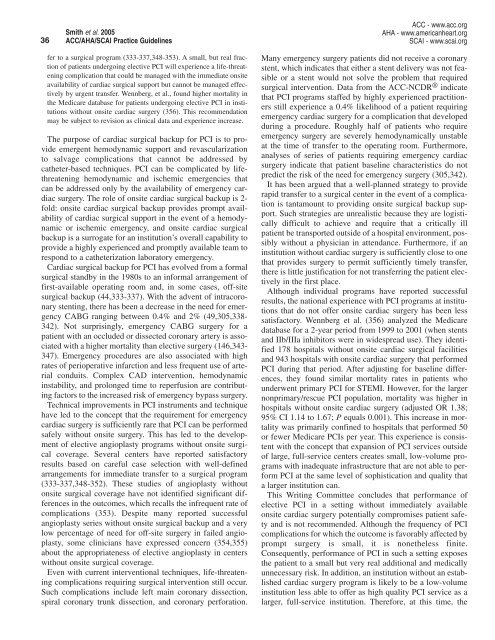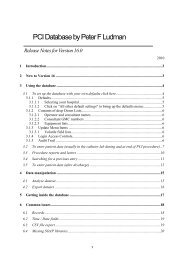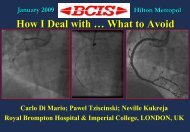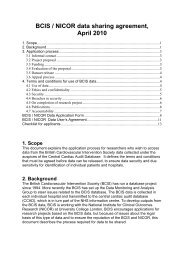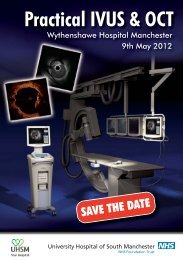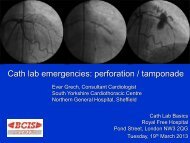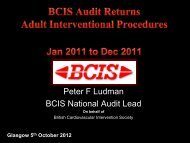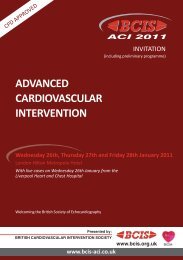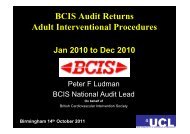Recommendations
ACC/AHA/SCAI PCI Guidelines - British Cardiovascular Intervention ...
ACC/AHA/SCAI PCI Guidelines - British Cardiovascular Intervention ...
- No tags were found...
You also want an ePaper? Increase the reach of your titles
YUMPU automatically turns print PDFs into web optimized ePapers that Google loves.
36<br />
Smith et al. 2005<br />
ACC/AHA/SCAI Practice Guidelines<br />
ACC - www.acc.org<br />
AHA - www.americanheart.org<br />
SCAI - www.scai.org<br />
fer to a surgical program (333-337,348-353). A small, but real fraction<br />
of patients undergoing elective PCI will experience a life-threatening<br />
complication that could be managed with the immediate onsite<br />
availability of cardiac surgical support but cannot be managed effectively<br />
by urgent transfer. Wennberg, et al., found higher mortality in<br />
the Medicare database for patients undergoing elective PCI in institutions<br />
without onsite cardiac surgery (356). This recommendation<br />
may be subject to revision as clinical data and experience increase.<br />
The purpose of cardiac surgical backup for PCI is to provide<br />
emergent hemodynamic support and revascularization<br />
to salvage complications that cannot be addressed by<br />
catheter-based techniques. PCI can be complicated by lifethreatening<br />
hemodynamic and ischemic emergencies that<br />
can be addressed only by the availability of emergency cardiac<br />
surgery. The role of onsite cardiac surgical backup is 2-<br />
fold: onsite cardiac surgical backup provides prompt availability<br />
of cardiac surgical support in the event of a hemodynamic<br />
or ischemic emergency, and onsite cardiac surgical<br />
backup is a surrogate for an institution’s overall capability to<br />
provide a highly experienced and promptly available team to<br />
respond to a catheterization laboratory emergency.<br />
Cardiac surgical backup for PCI has evolved from a formal<br />
surgical standby in the 1980s to an informal arrangement of<br />
first-available operating room and, in some cases, off-site<br />
surgical backup (44,333-337). With the advent of intracoronary<br />
stenting, there has been a decrease in the need for emergency<br />
CABG ranging between 0.4% and 2% (49,305,338-<br />
342). Not surprisingly, emergency CABG surgery for a<br />
patient with an occluded or dissected coronary artery is associated<br />
with a higher mortality than elective surgery (146,343-<br />
347). Emergency procedures are also associated with high<br />
rates of perioperative infarction and less frequent use of arterial<br />
conduits. Complex CAD intervention, hemodynamic<br />
instability, and prolonged time to reperfusion are contributing<br />
factors to the increased risk of emergency bypass surgery.<br />
Technical improvements in PCI instruments and technique<br />
have led to the concept that the requirement for emergency<br />
cardiac surgery is sufficiently rare that PCI can be performed<br />
safely without onsite surgery. This has led to the development<br />
of elective angioplasty programs without onsite surgical<br />
coverage. Several centers have reported satisfactory<br />
results based on careful case selection with well-defined<br />
arrangements for immediate transfer to a surgical program<br />
(333-337,348-352). These studies of angioplasty without<br />
onsite surgical coverage have not identified significant differences<br />
in the outcomes, which recalls the infrequent rate of<br />
complications (353). Despite many reported successful<br />
angioplasty series without onsite surgical backup and a very<br />
low percentage of need for off-site surgery in failed angioplasty,<br />
some clinicians have expressed concern (354,355)<br />
about the appropriateness of elective angioplasty in centers<br />
without onsite surgical coverage.<br />
Even with current interventional techniques, life-threatening<br />
complications requiring surgical intervention still occur.<br />
Such complications include left main coronary dissection,<br />
spiral coronary trunk dissection, and coronary perforation.<br />
Many emergency surgery patients did not receive a coronary<br />
stent, which indicates that either a stent delivery was not feasible<br />
or a stent would not solve the problem that required<br />
surgical intervention. Data from the ACC-NCDR ® indicate<br />
that PCI programs staffed by highly experienced practitioners<br />
still experience a 0.4% likelihood of a patient requiring<br />
emergency cardiac surgery for a complication that developed<br />
during a procedure. Roughly half of patients who require<br />
emergency surgery are severely hemodynamically unstable<br />
at the time of transfer to the operating room. Furthermore,<br />
analyses of series of patients requiring emergency cardiac<br />
surgery indicate that patient baseline characteristics do not<br />
predict the risk of the need for emergency surgery (305,342).<br />
It has been argued that a well-planned strategy to provide<br />
rapid transfer to a surgical center in the event of a complication<br />
is tantamount to providing onsite surgical backup support.<br />
Such strategies are unrealistic because they are logistically<br />
difficult to achieve and require that a critically ill<br />
patient be transported outside of a hospital environment, possibly<br />
without a physician in attendance. Furthermore, if an<br />
institution without cardiac surgery is sufficiently close to one<br />
that provides surgery to permit sufficiently timely transfer,<br />
there is little justification for not transferring the patient electively<br />
in the first place.<br />
Although individual programs have reported successful<br />
results, the national experience with PCI programs at institutions<br />
that do not offer onsite cardiac surgery has been less<br />
satisfactory. Wennberg et al. (356) analyzed the Medicare<br />
database for a 2-year period from 1999 to 2001 (when stents<br />
and IIb/IIIa inhibitors were in widespread use). They identified<br />
178 hospitals without onsite cardiac surgical facilities<br />
and 943 hospitals with onsite cardiac surgery that performed<br />
PCI during that period. After adjusting for baseline differences,<br />
they found similar mortality rates in patients who<br />
underwent primary PCI for STEMI. However, for the larger<br />
nonprimary/rescue PCI population, mortality was higher in<br />
hospitals without onsite cardiac surgery (adjusted OR 1.38;<br />
95% CI 1.14 to 1.67; P equals 0.001). This increase in mortality<br />
was primarily confined to hospitals that performed 50<br />
or fewer Medicare PCIs per year. This experience is consistent<br />
with the concept that expansion of PCI services outside<br />
of large, full-service centers creates small, low-volume programs<br />
with inadequate infrastructure that are not able to perform<br />
PCI at the same level of sophistication and quality that<br />
a larger institution can.<br />
This Writing Committee concludes that performance of<br />
elective PCI in a setting without immediately available<br />
onsite cardiac surgery potentially compromises patient safety<br />
and is not recommended. Although the frequency of PCI<br />
complications for which the outcome is favorably affected by<br />
prompt surgery is small, it is nonetheless finite.<br />
Consequently, performance of PCI in such a setting exposes<br />
the patient to a small but very real additional and medically<br />
unnecessary risk. In addition, an institution without an established<br />
cardiac surgery program is likely to be a low-volume<br />
institution less able to offer as high quality PCI service as a<br />
larger, full-service institution. Therefore, at this time, the


